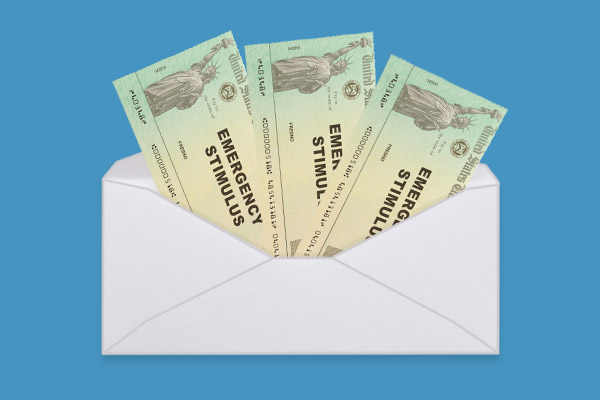The average Joe – not Biden – figures to benefit most from passage of the $1.9 trillion American Rescue Plan.
Approximately 145 million Americans will receive a third round of stimulus checks worth $1,400 per person from the bill approved by Congress and signed March 11 by President Joe Biden.
The latest gift from the federal government includes a wide range of measures aimed at middle-and-low-income Americans reeling from the economic effects of the coronavirus. It sailed through Congress with only minor touchups from Republicans and Democrats.
How Much Is the Third Stimulus Check?
The major takeaways for American consumers still struggling with the financial fallout from COVID-19 are:
- $1,400 stimulus check will be sent to single taxpayers with an adjusted gross income of less than $75,000 and married couples filing jointly, who made less than $150,000 in 2020.
- $1,400 stimulus checks for each dependent child 23-years-old and younger as well as aging dependent adults.
- A tax credit of $3,000 for children ages 6 to 17 and $3,600 credit for children under 6.
- An extension of the $300 per week supplement for those receiving unemployment benefits.
- $28 billion in rental assistance and $10 billion in mortgage payment assistance.
- If you have student loan debt canceled, either as part of current or future forgiveness programs, the money forgiven will no longer be taxed as income.
All of this is welcome news for the Average Jeans and Joes in America still trying to get back on their feet financially after the severe hit COVID-19 dealt the U.S. economy.
The American Rescue Plan means a married couple with two children would receive $5,600 ($2,800 for the couple, plus $2,800 for each child). A single mother with one child would receive $2,800.
The income cap to receive some portion of a stimulus check is $80,000 for singles, $160,000 for a couple filing jointly. That limit means approximately 15 million people who received money as part of the first two rounds of stimulus checks, won’t be getting a third round.
However, unlike the first two times COVID relief bills were passed, college students and elderly family members being cared for at home will qualify for the $1,400. The money will be distributed to the parent or caretaker claiming the dependent.
The American Enterprise Institute estimates that as many as 26 million more people will be eligible for a payment because of the addition of dependent adults.
The law also will send an additional $250 to $300 per month to lower income families thanks to an expansion of the child tax credit. There will be a credit of $3,000 per year for children aged 6 to 17 and $3,600 for those under 6. Payments would be distributed each month in amounts of $250 or $300.
This provision would last for one year, but Democrats already have stated their preference to make this permanent. The Center on Budget and Priorities says this will help bring almost 10 million kids close to or out of poverty. Credits would start to phase out for individuals earning more than $75,000 per year and couples earning more than $150,000.
Who Is Eligible for the Third Stimulus Check?
All taxpayers and earners who meet income requirements and have a Social Security number are eligible for the $1,400 Earned Income Payment.
To qualify for the payment, an individual filing 2019 or 2020 income tax as a single person had to make less than $75,000 in adjusted gross income. The limit for head of household is $112,500, and for married couples filing jointly $150,000.
Payments will be phased out between $75,000 and $80,000 for singles, $150,00 and $160,000 for married filing jointly.
This leads to some quirky math. Individuals who made $74,999 will receive $1,400. Those who made $80,001 will get nothing. The same applies to married couples who made $149,999 (full check) and those making $160,001 (no check).
Adult dependents will receive $1,400. The main people in this category figure to be unemployed adults living at home, college students and the elderly being cared for by a son or daughter at their home.
When Will You Get the Third Stimulus Check?
President Joe Biden said he wants the checks to start arriving before the end of March. The Treasury Department and IRS figure to use direct deposit to a bank account on record from previous tax returns to speed the process. Those who do not have direct deposit with the IRS will be mailed checks, which could take considerably longer to arrive.
The last time stimulus payments were sent out was late December and early January. The IRS was able to have those distributed within a few days of the stimulus bill’s signing. Anyone who wants to find out if their check has been sent can do so on the IRS site Get My Payment.
What If I Missed a Stimulus Payment in 2020?
Do not fret if for whatever reason you missed the $1,200 or $600 check, or both. The money can be claimed in the form of a tax refund.
The IRS has set up a Recovery Rebate Credit that would go on line 30 of the 2020 Form 1040 or 1040-SR. Filing electronically is the easiest way to address the situation. The IRS web site has a questionnaire to help you see if you are eligible and helps you calculate and determine that you should have received that money.
Help with Health Care Costs
The Rescue Act has significant help to those who buy health insurance on the individual markets set up by the Affordable Care Act.
There will be Increased subsidies for the cost of individual health insurance and a cap on what individuals pay for premiums at 8.5 percent of adjusted growth income. That means the family making $80,000 annually would pay a maximum of $6,800 per year in health care premiums, or $567 per month.
These changes were a campaign pledge of Biden, and will be in effect through the end of 2022.
Other Notable Parts of the Stimulus Bill
Some aspects of the bill worth knowing include:
- An extension of $300 supplements to unemployment benefits through Sept. 6. This may not be immediate though, as states may need time to set up the program. Any delayed benefits eventually would be paid in full.
- Exempting the first $10,200 of 2020 unemployment benefits from federal tax. Taxpayers who already filed 2020 returns would have to go back and file an amended return.
- A single taxpayer who made more than $80,000 in 2020 but less than that in 2021, an Economic Impact Payment based on their 2021 income when they file in 2022. The same is true for a married couple who makes less than $160,000 in 2021.
- $123 billion toward COVID treatment, which includes money for testing and vaccinations
- $360 billion for state and local governments that are required to balance budgets and lost significant revenue in the pandemic.
- $7.25 billion for the Paycheck Protection Program to help small businesses; this bill allows nonprofits to apply as well.
- $128 billion to help schools open safely.
- $28 billion in emergency rental assistance to those struggling to keep their apartments.
- $10 billion to homeowners struggling to make mortgage payments.
- The Small Business Administration will receive $25 billion for a new grant program to help restaurants and other food and drinking establishments.
How do Stimulus Checks Affect the Debt?
It sure doesn’t lessen it.
Congress has passed three rounds of stimulus and recovery aid, with stimulus checks alone accounting for $877 billion. The three laws passed in March and December 2020 and March of 2021 total $5 trillion. Some economists argue that with interest rates near zero, now is the time to make that commitment because it will cost very little extra to re-pay it and money in people’s pockets will keep the economy moving.
No matter how it’s viewed, $5 trillion is a hefty addition to the debt.
What’s Next?
Nobody hopes this happens, because if it is needed it means the pandemic will not be under control, which is not a pleasant thought.
But if one is necessary, it won’t happen until September of 2021 at the earliest, when extended unemployment help expires.
Republicans advocated ending the additional help with unemployment at the end of July, but Democrats balked because Congress traditionally takes an August recess and would not be present if the economy needed another jolt. Democrats pushed for extending the unemployment help until Sept. 6, which Sen. Jeff Merkley (D-Or.) said would be best because it meant Congress would be in session to address possible issues.
Free money from the government is great, but the hope of all lawmakers and the president is the pandemic is under control by that point, which will mean there would be no need for a fourth stimulus check.
Sources:
- N.A. (2021, March 1) H.R. 1319-American Rescue Plan Act of 2021. Retrieved from https://www.rpc.senate.gov/legislative-notices/hr1319_american-rescue-plan-act-of-2021
- Neubecker, R. (2021, March 9) F.A.Q. on Stimulus, Unemployment and Tax Rebates. Retrieved from https://www.nytimes.com/live/2021/03/06/business/stimulus-check-plan-details
- Rubin, Gabriel T. (2021, March 6) Stimulus Package Update: What’s in the COVID-19 Relief Bill. Retrieved from https://www.wsj.com/articles/stimulus-update-biden-covid-19-relief-package-11614095748?tesla=y








